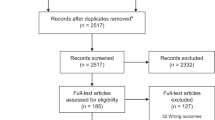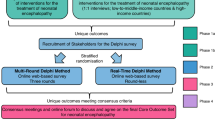Abstract
Objective:
We reviewed our decisions about continuation/withdrawal of life-sustaining treatments in a group of critically ill newborns who were discussed in structured medical ethical decision-making meetings, and provide the surviving children’s outcomes at 2-year follow-up.
Study Design:
In an explorative observational study, 61 cases were evaluated. The children involved had been discussed in such a structured way from 2009 to 2012 in a level III-D neonatal intensive care unit.
Results:
Decisions made were: full treatment (n=6), earlier restriction cancelled (n=3), treatment restriction (n=30) and palliative care (n=22). Parents of six children disagreed with the decision proposed. Thirteen (54%) of the 24 children who survived (39%) had moderate to severe neurological problems; 8 (33%) had additional sequelae; only one 2-year-old child was healthy.
Conclusions:
Decisions made varied to a large extent. The poor outcomes should be disseminated among decision makers. Future studies must explore new ways to improve outcome prediction, extend follow-up periods and consider what living with severe handicaps really means for both child and family.
This is a preview of subscription content, access via your institution
Access options
Subscribe to this journal
Receive 12 print issues and online access
$259.00 per year
only $21.58 per issue
Buy this article
- Purchase on Springer Link
- Instant access to full article PDF
Prices may be subject to local taxes which are calculated during checkout

Similar content being viewed by others
References
Walther FJ . Withholding treatment, withdrawing treatment, and palliative care in the neonatal intensive care unit. Early Hum Dev 2005; 81: 965–972.
Lam HS, Wong SP, Liu FY, Wong HL, Fok TF, Nq PC . Attitudes toward neonatal intensive care treatment of preterm infants with a high risk of developing long-term disabilities. Pediatrics 2009; 123: 1501–1508.
Verhagen AA, Dorscheidt JH, Engels B, Hubben JH, Sauer PJ . End-of-life decisions in Dutch neonatal intensive care units. Arch Pediatr Adolesc Med 2009; 163 (10): 895–901.
van der Heide A, Deliens L, Faisst K, Nilstun T, Norup M, Paci E et al. End-of-life decision-making in six European countries: descriptive study. Lancet 2003; 362: 345–350.
Barton L, Hodgman JE . The contribution of withholding or withdrawing care to newborn mortality. Pediatrics 2005; 116: 1487–1491.
Hagen CM, Hansen TW . Deaths in a neonatal intensive care unit: a 10-year perspective. Pediatr Crit Care Med 2004; 5: 463–468.
Larcher V, Craig F, Boghal K, Wilkinson D, Brierley J, on behalf of the Royal College of Paediatrics and Child Health. Making decisions to limit treatment in life-limiting and life treatnening conditions in children: a framework for practice. Arch Dis Child 2015; 100: S10–S23.
Sprung CL, Truog RD, Curtis JR, Joynt GM, Baras M, Michalsen A . Seeking worldwide professional consensus on the principles of end-of-life care for the critically ill. The Consensus for Worldwide End-of-Life Practice for Patients in Intensive Care Units (WELPICUS) Study. Am J Respir Crit Care Med 2014; 190: 855–866.
De Vos-Breurse MA . Sharing the burden of deciding. How physicians and parents make end-of-life decisions. Thesis, University of Amsterdam Ipskamp Press: Limmen, 2015.
Royal Dutch Medical Association (KNMG) Medical End-of-Life Decisions in Newborns with Severe Handicaps [Medische beslissingen rond het levenseinde bij pasgeborenen met zeer ernstige afwijkingen]. KNMG: Utrecht, 2013.
Verhagen E, Sauer PJ . The Groningen protocol—euthanasia in severely ill newborns. N Engl J Med 2005; 352: 959–962.
Beauchamp TL, Childress JF . Principles of Biomedical Ethics 6th edn Oxford University Press: Oxford, 2008.
Eden LM, Calliater LC . Parent involvement in end-of-life care and decision-making in the newborn intensive care unit: an integrative review. J Perinat Educ 2010; 19: 29–39.
Willems DL, Verhagen AAE, van Wijlick E . Infants’ best interests in end-of-life care for newborns. Pediatrics 2014; 134: e1163–e1168.
de Boer JC, van Blijderveeen G, van Dijk G, Duivenvoorden HJ, Williams M . Implementing structured, multiprofessional medical ethical decision-making in a neonatal intensive care unit. J Med Ethics 2012; 38: 596–601.
Parry G, Tucker J, Tarnow-Mordi W. UK Neonatal Staffing Study Collaborative Group. CRIB II: an update of the clinical risk index for babies score. Lancet 2003; 361: 1789–1791.
Catlin A, Carter B . Creation of a neonatal end-of-life palliative care protocol. J Perinatol 2002; 22: 184–195.
Bayley N . Bayley Scales of Infant and Toddler Development. The Psychological Corporation: San Antonio, TX, 2006.
NetChild Network for Childhood Disability Research Gross Motor Function Classification System, Expanded And Revised – Dutch Translation. NetChild Network for Childhood Disability Research: Utrecht, 2009.
Diekema DS, Botkin JR . Forgoing medically provided nutrition and hydration in children. Pediatrics 2009; 124: 813–822.
Porta N, Frader J . Withholding hydration and nutrition in newborns. Theor Med Bioeth 2007; 28: 443–451.
Wilkinson D . Death or Disability? The 'Carmentis Machine' and Decision-Making for Critically Ill Children. Oxford University Press: Oxford, 2013.
Cuttini M, Casotto V, de Vonderweid U, Garel M, Kollée LA, Saracci R . Neonatal end-of-life decisions and bioethical perspectives. Early Hum Dev 2009; 85 (Suppl 10): S21–S25.
McHaffie H, Lyon A, Hume R . Deciding on treatment limitation for neonates: the parents' perspective. J Pediatr 2001; 160: 339–344.
Janvier A, Farlow B, Baardsnes J, Pearce B, Barrington KJ . Measuring and communicating meaningful outcomes in neonatology: a family perspective. Semin Perinatol 2016; 40: 571–577.
Woodward LJ, Anderson PJ, Austin NC, Howard K, Inder TE . Neonatal MRI to predict neurodevelopmental outcomes in preterm infants. N Engl J Med 2006; 355 (7): 685–694.
Roberts G, Anderson PJ, Doyle LW. Victorian Infant Collaborative Study Group. The stability of the diagnosis of developmental disability between ages 2 and 8 in a geographic cohort of very preterm children born in 1997. Arch Dis Child 2010; 95 (10): 786–790.
Racine E . Ethics in neonatal neurology: when is enough, enough? Pediatr Neurol 2009; 40: 147–155.
Brecht M, Wilkinson DJ . The outcome of treatment limitation discussions in newborns with brain injury. Arch Dis Child Fetal Neonatal Ed 2015; 100 (2): F155–F160.
Acknowledgements
We acknowledge Jeroen Dudink and Liesbeth Smit for their valuable help in classifying the neurological problems at the time of SMMEDM and at 2-year follow-up, respectively. Ko Hagoort is thanked for editorial assistance.
Author information
Authors and Affiliations
Corresponding author
Ethics declarations
Competing interests
The authors declare no conflict of interest.
Additional information
Supplementary Information accompanies the paper on the Journal of Perinatology website
Supplementary information
Rights and permissions
About this article
Cite this article
de Boer, J., Gennissen, L., Williams, M. et al. Children’s outcomes at 2-year follow-up after 4 years of structured multi-professional medical-ethical decision-making in a neonatal intensive care unit. J Perinatol 37, 869–874 (2017). https://doi.org/10.1038/jp.2017.30
Received:
Revised:
Accepted:
Published:
Issue Date:
DOI: https://doi.org/10.1038/jp.2017.30



